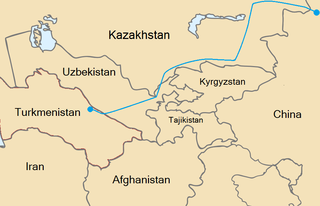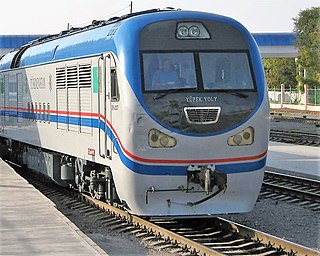
Central Asia is a region in Asia which stretches from the Caspian Sea in the west to China and Mongolia in the east, and from Afghanistan and Iran in the south to Russia in the north. The region consists of the former Soviet republics of Kazakhstan, Kyrgyzstan, Tajikistan, Turkmenistan, and Uzbekistan. It is also colloquially referred to as "the stans" as the countries generally considered to be within the region all have names ending with the Persian suffix "-stan", meaning "land of". Various neighbouring areas are sometimes also considered part of the region.
Transport in Turkmenistan includes such as roadways, railways, airways, seaways, waterways, oil, gas and water pipelines.
The Armed Forces of Turkmenistan, known informally as the Turkmen National Army is the national military of Turkmenistan. It consists of the Ground Forces, the Air Force and Air Defense Forces, Navy, and other independent formations.

Turkmenistan's declaration of "permanent neutrality" was formally recognized by the United Nations in 1995. Former President Niyazov stated that the neutrality would prevent Turkmenistan from participating in multi-national defense organizations, but allows military assistance. Its neutral foreign policy has an important place in the country's constitution. Although the Government of Turkmenistan claims to favour trade with and export to the United States and Turkey, it has significant commercial relationships with Russia and Iran and a growing cross-border trade with Afghanistan. The Government of Turkmenistan often appears to be trying to use the conflicting interests of these regional powers as a means to extract concessions from the others, especially on energy issues.

Ashgabat, formerly named Poltoratsk between 1919 and 1927, is the capital and the largest city of Turkmenistan. It is situated between the Karakum Desert and the Kopet Dag mountain range in Central Asia. It is also near the Iran-Turkmenistan border.

Turkmenistan, also known as Turkmenia, is a sovereign country in Central Asia, bordered by Kazakhstan to the northwest, Uzbekistan to the north and east, Afghanistan to the southeast, Iran to the south and southwest and the Caspian Sea to the west. Ashgabat is the capital and largest city of the country. The population of the country is 6 million, the lowest of the Central Asian republics. Turkmenistan is one of the most sparsely populated nations in Asia. Citizens of Turkmenistan are known as Turkmenistanis or Turkmen.

Balkanabat (Балканабат), formerly Nebit-Dag and Neftedag, is a city in western Turkmenistan and the capital of Balkan Province, the largest province in the country. It is located at 39°31′0″N54°22′0″E, at an altitude of 17 metres.

The Trans-Caspian Gas Pipeline is a proposed subsea pipeline between Türkmenbaşy in Turkmenistan, and Baku in Azerbaijan. According to some proposals it will also include a connection between the Tengiz Field in Kazakhstan, and Türkmenbaşy. The Trans-Caspian Gas Pipeline project is purposed to transport natural gas from Turkmenistan and Kazakhstan to European Union member countries, circumventing both Russia and Iran. It is also considered as a natural eastward extension of Southern Gas Corridor. This project attracts significant interest since it will connect vast Turkmen gas resources to major consumer geographies as Turkey and Europe.

The Central Asia–China gas pipeline is a natural gas pipeline system from Central Asia to Xinjiang in the People's Republic of China. By connecting Turkmenistan to China’s domestic grid, this pipeline makes it possible to transport gas some 7000 km from Turkmenistan to Shanghai. More than half of Turkmen natural gas exports are delivered to China through the pipeline.

The Central Asia – Center gas pipeline system is a Gazprom controlled system of natural gas pipelines, which run from Turkmenistan via Uzbekistan and Kazakhstan to Russia. The eastern branch includes the Central Asia - Center (CAC) 1, 2, 4 and 5 pipelines, which start from the south-eastern gas fields of Turkmenistan. The western branch consists of the CAC-3 pipeline and a project to build a new parallel Caspian pipeline. The western branch runs from the Caspian Sea coast of Turkmenistan to north. The branches meet in western Kazakhstan. From there the pipelines run to north where they are connected to the Russian natural gas pipeline system.

Iran and Turkmenistan share a common border of more than 1000 km. The two countries have good relations since Turkmenistan's independence from the Soviet Union in 1991. Since then, the two countries have enjoyed good relations and have cooperated in economic, transportation, infrastructure development, and energy sectors. The two nations have historic ties, with Turkmenistan having once been a part of ancient Persia and Greater Iran.

The following outline is provided as an overview of and topical guide to Turkmenistan:

Turkmenistan has 4,980 kilometres (3,090 mi) of railways. The railway operator is the state owned company Türkmendemirýollary. The company belongs to the Ministry of Railways of Turkmenistan.
Turkmenistan is a country with large potential for an expanded tourism industry. Many of its Central Asian cities were main points of trade on the Silk Road, linking Eastern and Western civilizations. Many neighboring countries promote their countries based on their location along the Great Silk Road. Tourism has grown rapidly in recent years. Tourists from abroad are deterred by the restrictive visa regime with all countries of the world. Tourism is regulated by the Tourism Committee of Turkmenistan.

Türkmendemirýollary Agency is a state-owned operator of railways in Turkmenistan. The company operates 4,980 km (3,090 mi) of railways and over 345 railway stations throughout the country. The company belongs to the Ministry of Industry and Construction Operation of Turkmenistan. It is headquartered in Ashgabat.
Science and Technology is Jordan's fastest-growing economic sector. This growth is occurring across multiple industries, including information and communications technology (ICTs), solar and wind energy and nuclear technology.
Science and technology in Kazakhstan outlines government policies to develop science, technology and innovation in Kazakhstan.
Science and technology in Uzbekistan examines government efforts to develop a national innovation system and the impact of these policies.
Science and technology in Kyrgyzstan examines government efforts to develop a national innovation system and the impact of these policies.
Science and technology in Tajikistan examines government efforts to develop a national innovation system and the impact of these policies.














